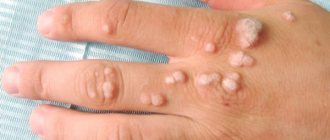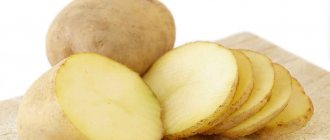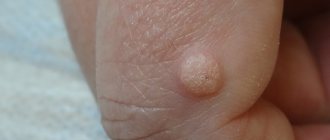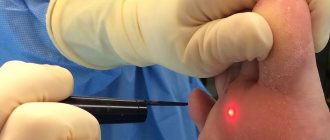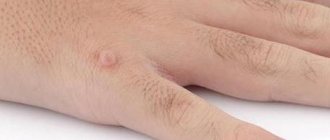AdminWarts Modern medicine and cosmetology offer many ways to treat warts, but ordinary vinegar is considered one of the most effective remedies against growths.
The acid quickly deals with both dense horny growths on the feet and soft, elastic papillomas on the hands. You can carry out the procedure at home, but for safe removal you should familiarize yourself with the processing rules and possible contraindications.
Is it possible to remove the growth with this product?
Removing warts with vinegar is a proven treatment method that can help get rid of the problem in just a few weeks. If you follow all the recommendations of specialists and precautions, you can remove skin growths with minimal discomfort.
To safely remove formations that appear due to infection with the papilloma virus, you can use only apple cider vinegar or table vinegar 3-9%.
The use of concentrated vinegar essence is strictly prohibited, as this liquid causes severe chemical burns to the skin and mucous membranes.
In addition, accidental inhalation of vapors often leads to burns of the upper respiratory tract, which poses a serious danger to human health and life.
Important!
Timely detection of pathology affects the success of therapy and its duration, because eliminating warty tumors at an early stage is much easier than with an advanced form of development.
What to use: acid, essence or regular vinegar
The product is available in 3 forms:
- acetic acid, called glacial;
- vinegar essence - an aqueous solution of acid with a strength of 70-80 percent;
- table vinegar, an aqueous solution of acid in a concentration of 6-9%.
For culinary purposes in everyday life, housewives often use the table type of the substance. If only 70% essence is available, you can make it less concentrated by preparing an aqueous solution yourself:
- 1 to 7 will yield 9% vinegar;
- 1 to 11 will give you 6% vinegar;
- 1 to 20 will give you 3% vinegar.
Removing warts with 70% acetic acid threatens the patient with burns to the respiratory system and skin, poisoning, long rehabilitation, and infection of the resulting wound.
For medical purposes, it is necessary to use a table type of substance, which is not inferior in effectiveness to its predecessor. It is forbidden to simultaneously burn a wart with vinegar and other chemicals: they will react and cause unpredictable health consequences.
Composition and mechanism of action on neoplasm
Apple cider vinegar is especially popular among patients because it has a gentle effect on warts without harming healthy cells.
The medicinal properties of the product are due to its chemical composition, which includes substances beneficial to the body such as:
- ascorbic acid;
- lactic, citric and oxalic acids;
- carbolic and propionic acids;
- magnesium, sodium and phosphorus;
- potassium and calcium;
- B vitamins;
- vitamins E, A and P.
Important!
Regular table vinegar is no less effective for treating seals, however, as a result of distillation and processing, it loses its beneficial properties. For this reason, many users give their preference to a natural product.
Once on the skin areas affected by papillomas, vinegar penetrates deep into the growth, provoking cell death and gradually burning out the seal.
Over time, the wart disappears, and in its place a small wound appears, which must be protected from infection and regularly treated with pharmaceutical drugs that accelerate tissue regeneration.
Causes of wart formation
The main cause of the appearance of warts on the body is the human papillomavirus, during the reproduction of which the epithelial tissue grows, as well as the subcutaneous layer, which is called the papillary layer. If the virus gets on the skin in one place, it begins to spread to other parts of the body. When it comes out, warts begin to form. This can happen under two conditions:
- Weakened immune system.
- Violation of the integrity of the skin.
Advantages and disadvantages of treatment
Removing warty growths with vinegar has a number of advantages over using special medications and alternative medicine recipes. The product is different:
- highly effective in combating large tumors;
- possibility of long-term use;
- natural composition;
- compatibility with medications;
- low toxicity;
- simplicity and ease of use;
- cheap and accessible.
Despite the considerable list of advantages, this method of treatment is not without its disadvantages. Among them:
- the appearance of unpleasant sensations during the procedure;
- the likelihood of getting burns;
- inability to use the product to remove warts from mucous membranes.
On the body
The human papillomavirus can affect absolutely any area on the body, and this is observed for the same reason, which is the use of the patient’s household items, visiting public places with high humidity, and lack of personal hygiene. Promiscuous sexual intercourse, as well as possible hypothermia of the human body, can also be added to the reasons for the development of the virus. Due to the last factor, neoplasms most often appear on the arms and legs. If the virus appears in the armpits, the cause may be excessive sweating.
Important nuances when cauterizing
Cauterization of growths with vinegar must be carried out taking into account certain rules and restrictions that cannot be ignored. In order for the treatment to be effective, the following points must be adhered to:
- Use only high-quality vinegar from a trusted manufacturer. You should also pay attention to the shelf life of the product and do not use it after the expiration date.
- Perform the treatment in the evening, preferably before bedtime - this way the compress or bandage will not interfere with daily activities.
- Do not stop treatment if the lump darkens - this sign indicates the imminent disappearance of the wart.
- Strictly observe hygiene standards, regularly changing dressings. Otherwise, pathogenic bacteria may enter the wound, which will lead to the development of an inflammatory process.
- To avoid relapse, after completing the course of treatment, continue using the product for 2-3 days, reducing the concentration of the medicinal solution and halving the number of procedures.
Important!
If severe itching, burning or rashes occur during the procedure, you should avoid self-treatment with vinegar and consult a dermatologist.
On the penis
If warts appear in the groin area, this indicates the development of a virus. This type of neoplasm is commonly called genital warts. They appear, in most cases, due to unprotected sexual intercourse, as well as during oral sexual contact. You can also become infected with this dangerous infection by using the personal items of a person who is a carrier of the virus. Infection can be acquired in a public place: sauna, bathhouse, swimming pool. Small formations on the skin are localized on the head of the penis, as well as on its shaft. A wart can appear on the frenulum of the foreskin, and is less common on the scrotum.
Recipes for preparing products with acetic acid
There are several effective recipes, the use of which guarantees the rapid removal of warts.
Onion and vinegar
Peel one small onion, cut into 4 parts and place in a container with 9% vinegar. Leave for at least three hours, then apply part of the onion to the growth for 15–20 minutes, securing it with a gauze bandage.
If you wish, you can use another recipe: chop the onion using a blender or fine grater, squeeze out the juice and add a tablespoon of 6% vinegar to it. Apply the product every day until the tumor completely disappears.
How to remove growth with apple cider vinegar?
You can use 6% store-bought apple cider vinegar to remove skin tags, but it is better to make your own.
Wash 4 large apples, dry them, cut them and squeeze out the juice. Pour the liquid into a glass jar, close the neck with a medical glove and leave in a dark, warm place for several days.
When the glove is very inflated, pour the apple juice into a wide bowl, cover with a cotton towel and leave for another 2 weeks. Then strain the liquid through cheesecloth and pour into a bottle. Store the medicine in a cool place.
Natural apple cider vinegar is used to treat warts both undiluted and in combination with additional ingredients: garlic, salt and orange peels.
Vinegar and flour cake
Combine two tablespoons of flour with 20 g of vinegar. Apply the prepared dough to the affected areas of the skin, wait until it dries and secure with a plaster or bandage. Repeat the procedure daily until the warty growth disappears.
The treatment must be completed so that the vinegar can penetrate into the deep layers of the compaction and remove the growth from the roots.
Garlic-vinegar infusion
Peel 3 cloves of garlic, pass through a press and pour in 100 ml of 9% vinegar. Infuse the remedy in the refrigerator for a week, and then use the liquid for compresses.
Important!
An infusion made from garlic and vinegar has an extremely aggressive effect on warts and healthy skin, so before using it you should make sure there are no contraindications.
Product combined with lemon
Cut half a lemon into slices, put it in a jar and pour in 50 ml of table vinegar. Close the lid tightly and let the product brew for 3 hours. Apply lemon slices to the growths twice a day for 10–15 minutes.
You can also mix the juice of a whole lemon with a tablespoon of 6% vinegar and apply the resulting liquid to the papillomas overnight. The duration of treatment is 5 days. If the warts do not disappear during this time, the course should be repeated after a week's break.
How to get rid of warts with vinegar?
Acetic acid has many beneficial qualities. The use is due to the disinfecting and disinfecting properties of the solution. The high acid content ensures flawless removal of warts with vinegar. Malic acetic acid, essence, table vinegar or an alcoholic solution of acetic acid are suitable for this. As it is applied, the acid penetrates the layers of the epidermis, burning not only the upper horizons of the skin, but also the roots of the growth.
Important! Depending on the size of the growth, removing warts with vinegar requires from a couple of days to 3 weeks. The advantage of the method is efficiency, the disadvantage is a high risk of skin burns.
There are two ways to remove growths: simple and complex. The first is used for small single formations, the second - for enlarged growths or when two foci of benign skin growths are located nearby.
Easy way
You should first wash the area of the growth with bacterial or regular soap and wipe the skin dry with a towel. Now apply a drop of vinegar to the skin growth, avoiding getting the product on a healthy area of skin. If you are not sure that the drugs will not spill, the application methods change: you can do everything with a cotton swab or disk. The end of the stick is dipped in vinegar and the lesion is treated. Twist a tourniquet from the disk and also, dipping one end of the tourniquet in vinegar, treat the lesion.
Instructions for use of Feresol solution and substitute analogues
There is a simple method for which only apple cider vinegar is suitable for warts - do not take the essence, it is dangerous! What to do:
- Soak a swab in vinegar;
- Secure the tampon with vinegar on the growth using an adhesive plaster;
- Leave overnight.
This option is suitable for fairly patient people, but using a tampon eliminates the risk of burning healthy tissue - the bandage is tightly attached to the wart. You need to apply the methods once a day; small growths are completely burned out in 3-5 days.
The hard way
Important! The procedure for using vinegar for warts is strictly prohibited for removing formations in the genital area, under the arms, and in areas of increased sweating.
It is used for larger growths of a benign nature or for warts with deep roots. How to do:
- Cut a hole the size of a wart in a piece of plaster;
- Apply the patch so that the growth is completely visible from the hole - this will protect healthy skin from burns;
- Drip vinegar onto cotton wool and cover the wart with cotton wool;
- Secure with a bandage.
A vinegar compress can be made for several hours. The procedure is carried out once a day until the wart dies completely. The effectiveness of any treatment is determined by a change in the shade of the formation: as soon as the head of the growth turns black, the process of necrosis begins. Now all that remains is to wait for the wart to separate from the skin on its own and heal the wound.
Surgitron device: principle of operation and areas of application of the radioknife
Advice! If the area of wart formation is hairy, then it is painful to remove the adhesive plaster. In this case, it is better to lubricate the cleansed skin with Vaseline, and prepare the adhesive plaster in such a way that the ends overlap - the bandage will stick tightly (one end will overlap the other), and it will be easy to tear off.
Processing rules
When treating growths with vinegar, it is important to follow simple rules:
- Wash your hands and affected skin areas thoroughly with antibacterial soap before performing the procedure.
- Pre-steam the new growths - this will help the product penetrate deep into the skin.
- Lubricate the healthy epithelium around the growth with fatty cream, petroleum jelly or vegetable oil to protect the skin from the effects of acid. You can also use an adhesive plaster with a hole cut for the wart.
- Treat seals with a clean cotton pad or a small piece of cotton soaked in medicinal liquid. It is convenient to apply the product using a pipette.
- Securely fix the cotton swab with a plaster or bandage.
Important!
If a scar forms on the skin after the wound has healed, it should be treated with corticosteroid ointments for 10–14 days.
Removing warts with medication
Destroying acids such as salicylic acid, trichloroacetic acid, urea and other special medicines are also wart removers. Any pharmacy offers a fairly wide selection of such drugs.
Salicylic acid, urea softens the top layer of the wart, in addition, stimulates the local immune response, and hence the disappearance of the wart. But when choosing to treat warts with medications, you need to be patient, because even if you use the product in strict accordance with the instructions, the effect becomes noticeable only after a few months.
Removing warts with medication
In addition, constant use of the drug is required according to a special scheme in compliance with certain skin care rules. Sometimes it causes discomfort to the patient and also the medicine has side effects such as skin irritation, redness, etc.
Therefore, many patients make a better decision - see a dermatologist and remove warts in faster and safer ways.
Precautionary measures
If the rules for safe use are not followed, the patient runs the risk of suffering many unpleasant consequences, so use vinegar to remove warty growths with caution.
In order not to cause irritation or burns to nearby areas of healthy skin, experts recommend carrying out the procedure with gloves and avoiding direct contact of the acid with the mucous membrane and delicate skin.
Important!
Before starting therapy, you must visit a dermatologist for diagnosis. If the doctor confirms the diagnosis and the benign nature of the growth, you can freely engage in independent treatment.
Removing warts with nitrogen
This is an alternative to laser wart removal. The method is also quite popular, but usually requires several procedures, they are quite painful, and after cryodestruction with liquid nitrogen a painful bubble forms. Therefore, removal of condylomas with liquid nitrogen is recommended only for older children and adults.
Removing warts with nitrogen
Cryodestruction is repeated every 2-3 weeks until the final disappearance of condylomas. Usually 6 sessions of liquid nitrogen treatment are sufficient, but if the wart still persists, other treatment options are considered. In addition, destruction with liquid nitrogen is not suitable in cases where the wart affects the area of the fingers and thighs.
Contraindications for use
The main contraindications to the use of vinegar to remove tumors at home are:
- individual intolerance to acetic acid;
- the presence of eczema, psoriasis or dermatitis;
- mechanical damage to the seal;
- increased skin sensitivity;
- age up to 12 years;
- period of pregnancy and lactation;
- rapid growth of papilloma;
- changes in the color, shape and structure of the wart;
- suppuration, bleeding or inflammation of the growth;
- degeneration of a benign tumor into a malignant tumor.
On the face
There are certain factors that contribute to the formation of warts on the face. These factors include:
- Improper or insufficient personal hygiene.
- Scratches and scratches.
- Using household items of an infected person.
- Disturbed hormonal levels during pregnancy or menopause.
- Weakened immune system.
- Presence of diabetes mellitus.
- Constant stress.
- Visiting a public place where there is high humidity, but hygiene is poor.
What can be replaced?
If the method of removing warts with vinegar is not suitable, you can use other means. Good replacements are:
- Iodine – has an antimicrobial, cauterizing and disinfecting effect. It has an aggressive effect on neoplasms of any density, therefore it is used only in diluted form.
- Potassium permanganate is an antiseptic that suppresses the proliferation of viruses and microbial activity. The product is suitable for treating warts on the face, but it acts rather slowly on lumps.
- Celandine juice has an immunostimulating, antitumor and antibacterial effect, eliminates pain and suppresses papillomavirus. Contains flavonoids that promote rapid wound healing.
In most patients, warty growths cause not only severe aesthetic discomfort, but also pain.
New growths that appear on the skin often interfere with wearing shoes, clothes or jewelry, so if nodules appear, you should begin treatment after consulting a doctor.
On the neck
The main source of the virus that provokes the formation of warts on the neck is also considered to be an infected carrier. During contact with it, growths may form on the skin. This picture is especially typical when wearing low-quality jewelry. In addition, there are other ways of infection, for example, those people who have diaper rash, abrasions, pimples on the neck, and weakened immunity should be considered at risk. The provoking factors in this case are colds, indigestion, taking antibiotics, and pregnancy.
Where do warts come from?
Warts owe their appearance to the human papillomavirus. Medical statistics show that most people have at least once encountered one or another type of papillomavirus. You can become infected with it:
- In case of close household or sexual contact with the skin of a person who has papillomas or warts on the body;
- When using objects that were used by a carrier of warts, including handrails, seats in public transport, public saunas, baths, swimming pools, water parks.
Growth factors
Through epithelial microdamage, viral DNA enters the body and disrupts healthy cell division processes, forming unsightly growths. Not every person who is attacked by HPV ends up with warts. Factors contributing to the formation of pathological growths include:
- Hormonal changes in the body, for example, during puberty, pregnancy, after childbirth or during menopause;
- Endocrine diseases;
- Chronic infectious diseases;
- Severe nutritional disorders and associated lack of vitamins and microelements;
- Increased sweating;
- Neglect of personal hygiene rules;
- Violations of work and rest schedules, prolonged exposure to stressful situations;
- Presence of unhealthy habits: smoking, drinking alcohol, drugs;
- Refusal to use condoms.
Important!
After entering the body, the virus can remain in “sleep mode” from several weeks to several months, waiting for the onset of suitable conditions. When the protective forces are weakened, it is activated, growing a benign neoplasm on the surface of the skin.
Signs of warts
It is quite easy to distinguish a wart from other growths by visual inspection. An experienced dermatologist will do this in one minute. Viral neoplasms are characterized by the following features:
- They grow quite quickly (sometimes in a matter of days), acquiring the shape of a tubercle or papilla;
- At the initial stage they have a smooth surface and look like a small blister, but over time they become rougher and rougher;
- There is no skin pattern on their surface;
- They do not cause pain to the owner unless they are injured or put pressure on them;
- When examining a wart, you can notice black dots in the middle - these are clogged capillaries;
- Over time, daughter growths may grow around the first growth.
Reviews
Alla
I had a wart on my thumb, right on the bend. She grew up very quickly, but there was not enough time to go to the doctor. I decided to help myself using folk methods. Using vinegar seemed quite logical. I applied it every day for about two weeks. Little by little pieces of rough skin fell off from above. A month later, it seemed to me, I was completely rid of it. But, after a couple of weeks, two more new warts grew in the same place and next to it! I urgently went to the doctor, where they were destroyed with a laser in 10 minutes.
Matvey
I removed the splint on my heel using my super product. I cut the lemon into pieces, poured acetic acid into them, let them sit well (about 3-4 days), and then applied the pieces to the wart and stuck them securely with an adhesive plaster. I repeated this every day. After a couple of days the spine turned white. I mixed a few drops of the resulting lemon vinegar with flour and stuck the cake to the wart overnight. In the morning I tore it off along with pieces of dead tissue. So he destroyed it completely.
Removal of warts and papillomas
Homemade or supermarket-bought natural apple cider vinegar contains about 60 different substances. These are organic compounds, mineral elements. The richness of the composition distinguishes the natural product from a solution of synthetic acetic acid with the addition of apple flavoring and dye.
Composition of natural apple cider vinegar:
- fruit acids, mainly acetic, malic, citric, oxaloacetic;
- provitamins and vitamins - beta-carotene, ascorbic acid, B1, B2, B6, E;
- macro- and microelements;
- enzymes (enzymes);
- amino acids;
- pectin.
There are several ways to fight warts using vinegar. The product is bought in the store or prepared at home from pieces of apples or peels. First, the raw materials are crushed, sugar and water are added (1.5 tbsp per 1 liter). Fermentation begins in a warm place, producing cider. After a week, the liquid is poured into another container, where acetic acid bacteria convert the alcohol into acids within a month.
Possible complications
Possible complications concern all types of removal of papillomas, warts and condylomas. First of all, this is a chemical burn.
Vinegar can cause redness of the skin around the growth, the appearance of small wounds and ulcers. They can not only make life difficult for their owners, but also lead to the appearance or increased growth of growths that they were trying to get rid of.
It is important to understand that some types of papillomas, if they are constantly injured, can become malignant.


